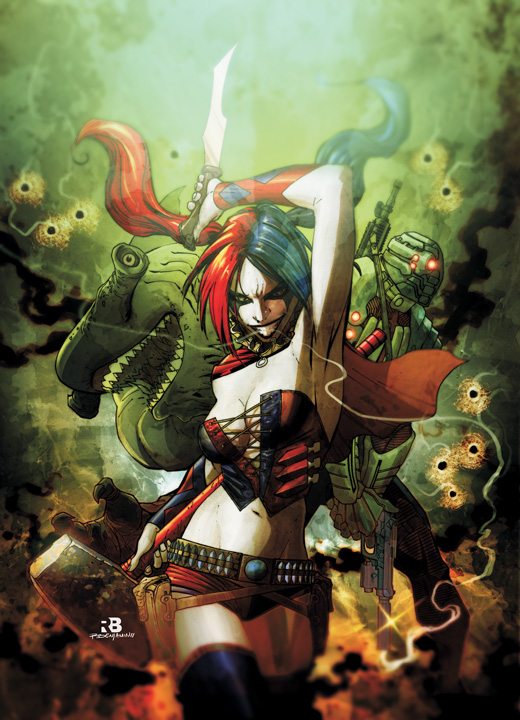Each weekday, Tim will take a look at what we know about each of the upcoming 52 new comics from the September DC relaunch, one series at a time. Today: SUICIDE SQUAD!
The Concept and Characters: Though the name “Suicide Squad” reflects back deeply into DCU history, it didn’t take off as a property worthy of a comic book series until John Ostrander and Luke McDonnell rebranded the concept as The Dirty Dozen With Supervillains in the 1987 spin-off from the Legends crossover. Based out of Belle Reve prison in Louisiana, that much-loved incarnation of the Suicide Squad featured tough-guy Rick Flagg and an ever-changing cast of criminals who were offered a simple choice: join the Suicide Squad and complete covert missions for the government, or stay in jail. Successful completion of their allotted time on the Squad would grant them freedom, but if they tried to run away, their electronic leashes would blow them to bits. Then, of course, there was also the strong possibility that they’d die while trying to complete the mission. They weren’t called the Suicide Squad just because it sounded catchy.
What made Ostrander and McDonnell’s run on the series so memorable were the strong characterizations of previously-minor DC characters like Captain Boomerang, or Deadshot, or the Bronze Tiger, but also the way the comic embraced a tone all its own. It may have crossed over with other superhero comics, and the Suicide Squad itself was populated with costumed characters, but it didn’t feel like any other capes-and-cowl comic. It was an action/espionage book, with characters who were sometimes literally at each others’ throats. It was hard-edged (for a mass-market comic of the 1980s, at least) and there was always something at stake.
There have been other attempts to do versions of the Suicide Squad in the decades since the Ostrander/McDonnell highlights, but their early work on the series looms over everyone who tries to follow, and even when Ostrander returned to the characters in a mini-series a few years back, it didn’t have the same energy it once did. The closest spiritual follow-up is probably Gail Simone’s work on Villains United and, later, the Secret Six. Though different conceptually, Simone’s work on those comics shows a debt to Ostrander’s use of quarreling supervillains working together toward a common goal.
DC’s September relaunch of the series brings the old concept back to life, with a harder edge. You can tell by the scant costume they gave the revamped Harley Quinn. Joining her on the team will be classic squad members like Deadshot, but also some z-listers like King Shark and Black Spider. Death row inmates as a covert ops team. Yup. Just like the good old days.
The Creative Team: Television writer and producer Adam Glass hasn’t done a whole lot of comic book work, but the little he has done is dreadful. Reading his most recent work on Flashpoint: Legion of Doom gives the impression that he not only has bad taste, but he doubles down with an eagerness to shock in the sleaziest way possible. It’s more than possible that the project—working with a book about a group of supervillains in a no-holds-barred alternative universe—led Glass down a particularly unpleasant path, but his work on those issues shows a strong tendency toward hammer-subtle declarative dialogue and inelegant plotting.
Coming off some Deadpool work for Marvel, much of his DC work so far reads like a parody of Geoff Johns’s excesses, but without Johns’s ability to nail the emotional high points and craft the tightly-interlocked mechanism of the story. Glass is likely to do a much trashier version of the Suicide Squad than you’ve ever seen before, and this isn’t a team known for its grace and dignity.
Or, as he phrases it, this new incarnation will be, “Harder, smarter, less cheese.”
Kind of hard to believe the “less cheese” bit, after reading any of his other comics.
Fortunately for Glass, Marco Rudy is a superstar mainstream comic book artist, it’s just that barely anyone knows about it yet. He hasn’t done an incredible amount of work in the past few years, but much of the work he has done has been incredible. His inventive page layouts and willingness to shift up his style to create the appropriate tone for the scene show him to be an artist in the mold of a young J. H. Williams III. He clearly takes inspiration from Williams, and though he doesn’t yet have quite the facility as the veteran, he is constantly pushing his comic book pages to do more visually, to break free from many of the storytelling conventions that make most superhero comics look interchangeable.
His often ornate and always ambitious pages will surely provide a strange contrast to the simple brutality of Glass’s scripts. If Rudy can stick to the monthly deadline (and that is a big question mark), this series could be worth picking up just to look at the pages.
Recommendation: Skip it. Glass writes comics like he’s banging on the typewriter with a festering sledgehammer, and though Rudy’s art is always worth checking out, he’s not all that likely to be around much after the first couple of issues. This series may hold some interest from the rubberneckers who enjoy reading the superhero version of a car wreck, but as much as Glass promises a “smarter” series, he’ll have to prove that he can write something even bordering on intelligence before this series will be a monthly destination for readers.
Tim Callahan writes about comics for Tor.com, Comic Book Resources, Back Issue magazine, and his own Geniusboy Firemelon blog.










